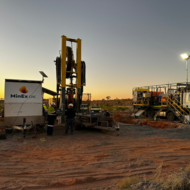WA-based drilling initiative set to address declining rates of mineral discovery
| Date: | Thursday, 17 August 2023 |
|---|
- Program will apply novel drilling techniques in remote regions across the State
- Geological Survey of Western Australia providing expertise and funding
A collaborative drilling initiative is set to address declining mineral discovery rates by mapping and defining potential mineral systems in remote, underexplored regions of Western Australia.
The Geological Survey of Western Australia (GSWA) is collaborating with the MinEx Cooperative Research Centre as part of an ongoing pre-competitive geoscience program, the National Drilling Initiative (NDI).
While not an exploration program itself, the initiative aims to reduce the financial and technical risks of exploration and increase the level of industry investment by providing high-quality precompetitive geoscience data.
Phase one the WA campaign is underway at the Nifty copper operation in the Paterson region of the State’s North West. Nifty is currently under care and maintenance.
This stage of the work will drill multiple holes to depths of up to 500 metres in order to understand the geological factors controlling the sedimentary-hosted copper system.
The drill crews will use novel coiled tube (CT) technology developed to access bedrock in a faster, cheaper and more environmentally cleaner manner. CT drilling emits less carbon dioxide, is less water intensive than other techniques that access similar depths, and uses a smaller site footprint than comparable drill rigs.
The work at Nifty is at a much larger scale than typical exploration operations with the farthest drill hole around 25 kilometres from the ore body.
To ensure the work does not affect cultural heritage sites, the Paterson campaign is using existing drill pads in previously disturbed areas.
GSWA Executive Director Michele Spencer said sedimentary-hosted copper systems account for around 20 per cent of global production.
“Despite copper’s importance in driving net zero emissions, very little is understood geologically about sedimentary copper systems,’ Ms Spencer said.
“In WA, large low-lying areas like the Canning Basin and Officer Basin show considerable potential for base metals such as copper, but the extent of this prospectivity is unknown.
“The Paterson is an important exploration frontier and the geoscience data we collect at the Nifty site will play an important role in driving exploration across the region and WA.
GSWA’s participation in the NDI is being funded by the State Government’s Exploration Incentive Scheme.
The team at Nifty expect to complete the drilling program in four to six weeks, with preliminary data being released later this year and made freely available through the GSWA and MinEx data portals.
For more information, visit:
http://www.dmp.wa.gov.au/Geological-Survey/MinEx-CRC-GSWA-NDI-Drilling-31389.aspx
GSWA provides objective and authoritative geoscientific data, information and services to support the responsible use of Western Australia’s natural resources.
MinEx CRC is the world’s largest mineral exploration collaboration bringing together industry, government and research organisations.

